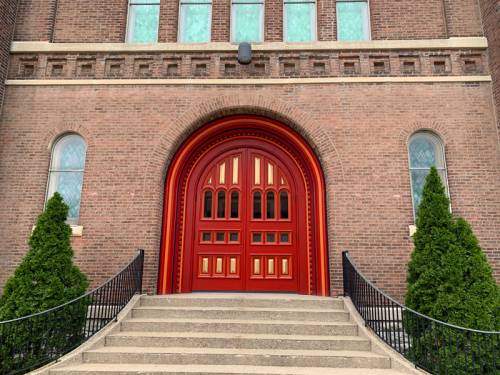Church creates a ‘mini-me’ outdoor food pantry
by Darla Carter | Presbyterians Today

Not wanting to leave hungry neighbors out in the cold when the church building was shuttered due to COVID-19, First Presbyterian Church continued its mission to feed the community with a micropantry. Courtesy of First Presbyterian Church
First Presbyterian Church in Springfield, Illinois, has a history of providing social services for the community. So having to shut down its traditional food pantry last year as a COVID-19 precaution was tough for members. “That was really hard because it’s such a significant ministry in our congregation,” said the Rev. Susan Phillips, the church’s pastor.
Unwilling to abandon its neighbors, First Presbyterian found other ways to help people in need, such as redirecting funds to a homeless shelter and other service providers in the community. But it is one of the church’s tiniest gestures that’s attracting the most attention: a micropantry. While micropantries — which are basically outdoor storage cabinets that people can access at any time of day to obtain food and personal items — have been growing in popularity in recent years, last year’s pandemic turned the trend into a necessity, allowing people to get food without having to enter into an enclosed space.
“There’s an honor system,” Phillips said about micropantries. “Whatever it is you have, you can leave. Whatever it is you need, you can take. It feels very much like the early church: They give according to what they have, and they receive according to their needs.”

The iconic red doors of First Presbyterian Church in Springfield, Illinois — doors that Abraham and Mary Todd Lincoln once walked through — were the inspiration for its outdoor mini food pantry. Courtesy of First Presbyterian Church
First Presbyterian’s micropantry, though, is unique, going beyond a simple boxlike structure. It was designed to resemble the church that Abraham and Mary Todd Lincoln once attended. Like the building itself, the micropantry, for example, has distinctive front doors and a Tiffany-style window depicting a dove in flight.
“I like to build little things like that, so I just went ahead and built it,” said Don Ecklund, the church’s Habitat for Humanity representative. “Our church is well-known for its red doors, so I thought, ‘Oh, I’ll just paint red doors on this pantry to make it look cute.’”
Ecklund, a retired sociology teacher, had been involved in a similar project, the building of the first Little Free Library in Springfield about 10 years prior, so the church tapped him to erect the micropantry.
Ecklund credits part of the project to Linda Justice, a friend whom he ran into at a park and invited to help him complete the micropantry, which is located on the church grounds.
“It’s very windy where I put it up, so I needed another person to hold things up in the wind while I tried to put it together, so she was a very, very big help,” he said of Justice, who sometimes attends First Presbyterian and was homeless during the project.
Since its completion, the micropantry has attracted the attention of local media and USA Today as well as a nearby Lutheran church that’s helping to keep the micropantry stocked. “I’m kind of surprised how much buzz just painting some doors on the micropantry has generated,” Ecklund said.
First Presbyterian’s project is thought to be the 33rd micropantry in Springfield, Phillips said. The congregation also stocks a micropantry a few blocks from the church.
“Sharing what we have and caring for those in need are longstanding traditions,” Phillips said. “Part of the conversation that we have here is that if someone has an immediate need, there should be a charitable response. If someone is hungry, they need food today. If they have no place to go, they need shelter tonight. If they’re ill or injured, they need medical care right now.”
First Presbyterian, the home of Samaritan Ministries, also is concerned about the root causes of hunger and homelessness and how to address them, Phillips said.
“We’re hoping that this being a news story can prompt conversations in our communities and other places about the causes of hunger and the causes of poverty, and some of those conversations are going to be about things like the need to pay people living wages or to ensure the affordability of housing or accessibility of health care, or equity when it comes to employment and education and in our legal system,” she said. “So, for me, this pantry is one small piece in a larger fabric of how our spiritual gifts and our sense of call are woven together with the circumstances and situations in our community, and how, as people of faith, we can participate in those conversations about what it means to live into God’s love and justice.”
Similarly, Ecklund said he would like to see the government doing more to end hunger. “We have plenty — and plenty of food, so rather than just putting up minipantries, there should be programs that make sure that everyone has enough food and everyone has shelter.”
Katharine P. Eastvold is volunteer administrator of Families Helping Families, a Facebook group that, among other things, maintains a list of micropantry locations and spreads the word about them so the people of Springfield will continue to stock them and make donations.
“I really, really have been impressed at how people have stepped up during the pandemic, and particularly with the micropantries,” she said. “It’s really amazing.”
Darla Carter is a communications associate for the Presbyterian Mission Agency.



No comments:
Post a Comment